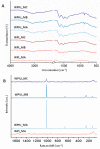Marine-Inspired Enzymatic Mineralization of Dairy-Derived Whey Protein Isolate (WPI) Hydrogels for Bone Tissue Regeneration
- PMID: 32498225
- PMCID: PMC7344948
- DOI: 10.3390/md18060294
Marine-Inspired Enzymatic Mineralization of Dairy-Derived Whey Protein Isolate (WPI) Hydrogels for Bone Tissue Regeneration
Abstract
Whey protein isolate (WPI) is a by-product from the production of cheese and Greek yoghurt comprising β-lactoglobulin (β-lg) (75%). Hydrogels can be produced from WPI solutions through heating; hydrogels can be sterilized by autoclaving. WPI hydrogels have shown cytocompatibility and ability to enhance proliferation and osteogenic differentiation of bone-forming cells. Hence, they have promise in the area of bone tissue regeneration. In contrast to commonly used ceramic minerals for bone regeneration, a major advantage of hydrogels is the ease of their modification by incorporating biologically active substances such as enzymes. Calcium carbonate (CaCO3) is the main inorganic component of the exoskeletons of marine invertebrates. Two polymorphs of CaCO3, calcite and aragonite, have shown the ability to promote bone regeneration. Other authors have reported that the addition of magnesium to inorganic phases has a beneficial effect on bone-forming cell growth. In this study, we employed a biomimetic, marine-inspired approach to mineralize WPI hydrogels with an inorganic phase consisting of CaCO3 (mainly calcite) and CaCO3 enriched with magnesium using the calcifying enzyme urease. The novelty of this study lies in both the enzymatic mineralization of WPI hydrogels and enrichment of the mineral with magnesium. Calcium was incorporated into the mineral formed to a greater extent than magnesium. Increasing the concentration of magnesium in the mineralization medium led to a reduction in the amount and crystallinity of the mineral formed. Biological studies revealed that mineralized and unmineralized hydrogels were not cytotoxic and promoted cell viability to comparable extents (approximately 74% of standard tissue culture polystyrene). The presence of magnesium in the mineral formed had no adverse effect on cell viability. In short, WPI hydrogels, both unmineralized and mineralized with CaCO3 and magnesium-enriched CaCO3, show potential as biomaterials for bone regeneration.
Keywords: bioinspired; composite; enzyme; hydrogel; mineralization; whey protein isolate.
Conflict of interest statement
The authors declare no conflict of interest.
Figures






Similar articles
-
Enzymatic, urease-mediated mineralization of gellan gum hydrogel with calcium carbonate, magnesium-enriched calcium carbonate and magnesium carbonate for bone regeneration applications.J Tissue Eng Regen Med. 2017 Dec;11(12):3556-3566. doi: 10.1002/term.2273. Epub 2017 Jun 1. J Tissue Eng Regen Med. 2017. PMID: 28569438
-
Mineralization of gellan gum hydrogels with calcium and magnesium carbonates by alternate soaking in solutions of calcium/magnesium and carbonate ion solutions.J Tissue Eng Regen Med. 2018 Aug;12(8):1825-1834. doi: 10.1002/term.2675. Epub 2018 Jun 27. J Tissue Eng Regen Med. 2018. PMID: 29701014
-
Endothelialization of Whey Protein Isolate-Based Scaffolds for Tissue Regeneration.Molecules. 2023 Oct 12;28(20):7052. doi: 10.3390/molecules28207052. Molecules. 2023. PMID: 37894531 Free PMC article.
-
Mineralization of hydrogels for bone regeneration.Tissue Eng Part B Rev. 2010 Dec;16(6):577-85. doi: 10.1089/ten.TEB.2010.0462. Epub 2010 Oct 8. Tissue Eng Part B Rev. 2010. PMID: 20735319 Review.
-
Journey of Mineral Precursors in Bone Mineralization: Evolution and Inspiration for Biomimetic Design.Small. 2024 Jan;20(3):e2207951. doi: 10.1002/smll.202207951. Epub 2023 Aug 24. Small. 2024. PMID: 37621037 Review.
Cited by
-
Milk protein-based hydrogels: Development and biomedical applications.Biomater Transl. 2025 Jun 25;6(2):127-150. doi: 10.12336/bmt.24.00071. eCollection 2025. Biomater Transl. 2025. PMID: 40641996 Free PMC article. Review.
-
Preliminary Preclinical Evaluation of Innovative Bone Scaffolds Composed of Natural Sources-Whey Protein Isolate and Pearl Powder.Int J Mol Sci. 2025 Aug 17;26(16):7939. doi: 10.3390/ijms26167939. Int J Mol Sci. 2025. PMID: 40869260 Free PMC article.
-
Anti-Inflammatory and Osteogenic Effect of Phloroglucinol-Enriched Whey Protein Isolate Fibrillar Coating on Ti-6Al-4V Alloy.Polymers (Basel). 2025 May 29;17(11):1514. doi: 10.3390/polym17111514. Polymers (Basel). 2025. PMID: 40508757 Free PMC article.
-
Whey Protein Isolate and β-Lactoglobulin-Modified Alginate Hydrogel Scaffolds Enhance Cell Proliferation for Cultivated Meat Applications.Foods. 2025 Jul 19;14(14):2534. doi: 10.3390/foods14142534. Foods. 2025. PMID: 40724354 Free PMC article.
-
Formulation and Evaluation of Licorice-Extract-Enhanced Chitosan, PVA, and Gelatin-Derived Hydrogels for Wound Dressing.Bioengineering (Basel). 2025 Apr 23;12(5):439. doi: 10.3390/bioengineering12050439. Bioengineering (Basel). 2025. PMID: 40428058 Free PMC article.
References
-
- Douglas T.E.L., Vandrovcova M., Krocilova N., Keppler J.K., Zarubova J., Skirtach A.G., Bacakova L. Application of whey protein isolate in bone regeneration: Effects on growth and osteogenic differentiation of bone-forming cells. J. Dairy Sci. 2018;101:28–36. doi: 10.3168/jds.2017-13119. - DOI - PubMed
-
- Dziadek M., Kudlackova R., Zima A., Slosarczyk A., Ziabka M., Jelen P., Shkarina S., Cecilia A., Zuber M., Baumbach T. Novel multicomponent organic–inorganic WPI/gelatin/CaP hydrogel composites for bone tissue engineering. J. Biomed. Mater. Res. Part A. 2019;107:2479–2491. doi: 10.1002/jbm.a.36754. - DOI - PubMed
-
- Dziadek M., Douglas T.E., Dziadek K., Zagrajczuk B., Serafim A., Stancu I.-C., Cholewa-Kowalska K. Novel whey protein isolate-based highly porous scaffolds modified with therapeutic ion-releasing bioactive glasses. Mater. Lett. 2020;261:127115. doi: 10.1016/j.matlet.2019.127115. - DOI
-
- Gupta D., Kocot M., Tryba A.M., Serafim A., Stancu I.C., Jaegermann Z., Pamuła E., Reilly G.C., Douglas T.E. Novel naturally derived whey protein isolate and aragonite biocomposite hydrogels have potential for bone regeneration. Mater. Design. 2020;188:108408. doi: 10.1016/j.matdes.2019.108408. - DOI
MeSH terms
Substances
Grants and funding
LinkOut - more resources
Full Text Sources

